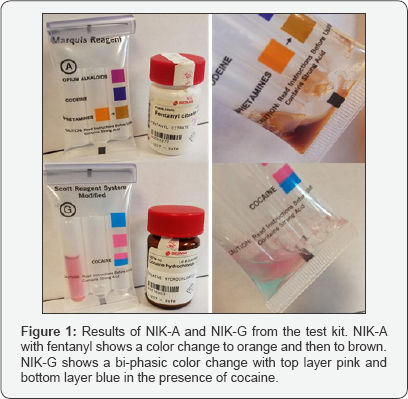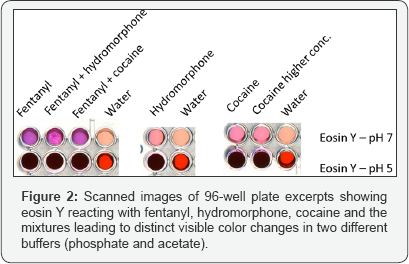A New Possible Alternative Colorimetric Drug Detection Test for Fentanyl
Michael J Kangas*, David Symonsbergen and Andrea E Holmes
Department of Chemistry, Doane University, USA
Submission: December 01, 2017; Published: December 11, 2017
*Corresponding author: Michael J Kangas, Department of Chemistry, Doane University, USA, Tel: (402)826-8325; Fax: (402)826-8278; Email: Michael.kangas@doane.edu
How to cite this article: Michael J K, David S ,Andrea E H. A New Possible Alternative Colorimetric Drug Detection Test for Fentanyl. Organic & Medicinal Chem IJ. 2017; 4(4): 555645.DOI:10.19080/OMCIJ.2017.05.555645
Abstract
A new colorimetric test using eosin Y has been developed to detect fentanyl and fentanyl mixed with cocaine and hydrocodone. This assay can be performed in solution or on a solid support, such as a piece of paper. While fentanyl can be tested with the established and currently used Marquis reagent and cocaine with the Modified Scott test, eosin Y may be an attractive alternative or complimentary test for drug identification.
Keywords: Fentanyl; Colorimetric; Sensor
Introduction
Law enforcement and correctional officers use colorimetric spot tests to make a quick on site presumptive identification when a potential drug is seized from a suspect. Modern instrumental methods for drugs of abuse have yet to replace wet chemical colorimetric assays for rapid lab and field screening of suspected material [1-15]. Instrumental techniques can be time intensive and costly, requiring technical expertise in addition to being location-bound. Alternatively, simple colorimetric assays (i.e. "spot tests”) offer speed, simplicity of operation, portability, and affordability [12-15]. The stability and versatility of these spot tests enable lab scientists to "triage” samples for additional drug analysis, as well as providing quick answers to law enforcement officers or crime scene analysts in the field. A number of spot tests, e.g. Marquis, Duquenois- Levine, and Scott, utilize an array of reagents with various handling requirements [12-15].
These tests often use caustic reagents, such as strong acids or bases [12-15]. While demonstrating impressive analytical power, these spot tests are often characteristic for a class of compounds relying on the reactivity of a specific chemical functional group. Fentanyl is an opioid that has been used in palliative care because it is more potent than morphine [16]. Many overdoses and deaths have been associated with fentanyl when mixed with other cocaine or opioids like hydrocodone and heroin [17]. Forensic scientists, law enforcement, and correctional officer's use color spot tests to conduct presumptive testing of these analytes [18]. Herein we introduce eosin Y, a new spot test device for lab and potential field use. Eosin Y can be used as a mix-and- measure assay or a spot test on paper providing a stable color change for the rapid detection of fentanyl and a mixture with cocaine or hydrocodone.
Methods and Procedures:
a. Mix and Measure Assay: Marquis and Modified Scott Test: Tests A (Marquis) and G (Modified Scott) were purchased from the Safariland Group (NIK Public Safety), and the procedure was performed as per operator instructions included with the NIK test kit. Eosin Y was dissolved at 400mM either in pH=7 phosphate buffer or pH=5 acetate buffer to yield a 150 μM stock solution. 150 μL of the eosin Y solution was placed into wells of a 96 well optical bottom plate. 150 μL aliquots of fentanyl and fentanyl/cocaine/ hydrocodone (10mg/ml) solution were added to the eosin Y wells. Color changes were instantaneous, and the plates were immediately scanned with a desktop scanner.
b. Paper Assay: Eosin Y was dissolved in a print solution adapted from a previously reported formulation. The formulation was added to the print cartridge in a commercial desktop printer and then printed on paper [19].
c. Drugs: Fentanyl, cocaine, and hydrocodone were purchased from Sigma Aldrich with a DEA license.
Results and Discussion
Figure 1 shows the results of when fentanyl was tested with the NIK-A test (Marquis Test) and cocaine with NIK-G test (Modified Scott Test). With the NIK-A test, fentanyl immediately afforded an orange color that darkened and changed to brown over 3-minutes. When cocaine was tested in the NIK-G test, the final result was a top pink layer over a bottom blue layer. These results agree well with the published color charts from the Safariland Group. Figure 2 shows a scanned image of fentanyl and fentanyl mixed with hydrocodone and cocaine in eosin Y in a mix and measure assay. When compared to the control (water), the color changes are visible to the naked eye in phosphate buffer (eosin Y, pH= 7) and acetate buffer (eosin Y, pH=5), indicating that fentanyl can be easily discriminated in eosin Y and identified when compared to a control, such as water which readily dissolves fentanyl.


Figure 3 shows eosin Y printed on paper with a desktop printer. Eosin Y is printed in a dark pink color. In comparison to the control (water), the addition of fentanyl and hydromorphone led to distinct color changes while cocaine did not. The water must be solubilizing eosin y on paper and wash the sensor off the paper. In the presence of cocaine, this washing effect persists. However, hydromorphone and fentanyl do not exhibit this behavior, thus keeping the sensor deposited on the paper leading to a color change. This is advantageous for testing because analytes that are dissolved in water should not interact with the sensor and wash it off. Thus, while this paper based assay shows that cocaine is not a suitable analyte due to the washing effect, it does work well with fentanyl and hydrocodone.

Conclusion
Eosin Y has excellent potential for use in the field. The dye is “inactive” until use. Other practical benefits of this assay include ease-of-use, low sample volume requirements, and the use of safe and non-toxic reagents. The data shown in the mix and measure assay reveals a reasonably high specificity among fentanyl, and common mixing agents for fentanyl, like cocaine and hydromorphone. The paper assay is more limited as it does not allow cocaine to react with the sensor. However, fentanyl and hydromorphone interact well with the paper assay and lead to visible color changes. Research is ongoing with other controlled substances and cutting agents to explore the utility of eosin Y as a drug sensor. In conclusion, the eosin Y test could present an alternative or complimentary spot test to the commercially available NIK Tests.
Acknowledgement
We thank Andres Mora for assisting with the print solutions. This work is funded by W911SR-16-C-0051 SBIR Phase I - SBIR Phase 2 Chemical Biological Radiological Nuclear and Explosives (CBRNE) Reconnaissance Sampling Kit.
References
- AI Golovko, SI Golovko (2002) The influence of ethanol on the functional status of GABAa receptors. Biochemistry 67(7): 719-729.
- J Karle, MR Witt, M Nielsen (1997) The use of in vivo antisense oligonucleotide technology for the investigation of brain GABA receptors. Neurochem Int 31(3): 437-446.
- MA El Sohly, SJ Salamone (1999) Prevalence of drugs used in cases of alleged sexual assault. J Anal Toxicol 23(3): 141-146.
- M Kollroser, C Schober (2002) Simultaneous analysis of flunitrazepam and its major metabolites in human plasma by high performance liquid
- D Armstrong, KL Rundlett, UB Nair (1996) Enantioresolution of amphetamine, methamphetamine and deprenyl (Selegiline) by LC, GC, and CE. Curr Sep 15(2): 57-61.
- Q Huang, X He, C Ma, R Liu, S Yu, et al. (2000) Pharmacore/receptor models for GABA/BzR Subtypes via comprehensive ligand mapping approach. J Med Chem 43(1): 71-95.
- A Negrusz, C Moore, D Deiterman, D Lewis , K Kaleciak, et al. (1999) Highly sensitive micro-plate enzyme immunoassay screening and NCI-GC-MS confirmation of flunitrazepam and its major metabolite 7-aminoflunitrazepam in hair. J Anal Toxicol 23(6): 429-435.
- A Negruz, C Moore, K Hinkel, TL Stockham, M Verma, et al. (2001) Deposition of 7- aminoflunitrazepam in hair after a single dose of Rohypnol. J Forensic Sci 46(5): 1143-1151.
- B Alberts, D Bray, J Lewis, M Raff, K Roberts, et al. (1994) Molecular Biology of the Cell. (3rd edn), Garland Publishing, Inc, New York, USA.
- R Dams, T Benijts, WE Lambert, AP De Leenheer (2002) Simultaneous determination of in total 17 opium alkaloids and opioids in blood and urine by fast liquid chromatography-diode -array detection- fluorescence detection, after solid phase extraction. J Chrom 773: 5361.
- GM Hanna (2006) NMR regulatory analysis: enantiomeric purity determination for (R)-(-)- desoxyephedrine and antipode methamphetamine. Pharmazie 61(3): 188-193.
- CL O'Neal, DJ Crouch, AA Fatah (2000) Validation of twelve chemical spot tests for the detection of drugs of abuse. Forensic Sci Int 109(3): 189-201.
- JA Morris (2007) Modified cobalt thiocyanate presumptive color test for ketamine hydrochloride. J Forensic Sci 52(1): 84-87.
- Office of Science and Technology (2000) Color test reagents/kits for preliminary identification of drugs of abuse. National Institute of Justice, Washington, DC, USA.
- United Nations (1994) Rapid testing methods of drugs of abuse. Vienna: United Nations International Drug Control Programme.
- (2016) Drug Facts: Fenantyl. National Institute on Drug Abuse, US National Institutes of Health.
- MJ Hull, M Juhascik, F Mazur, MA Flomenbaum, GS Behonick (2007) Fatalities Associated with Fentanyl and Co-administered Cocaine or Opiates. J Forensic Sci 52(6): 1383-1388.
- SH Johns, AA Wist, AR Najam (1979) Spot Tests: A Color Chart Reference for Forensic Chemists. J Forensic Sci 24(3): 631-649.
- TH Doan, TA Doan, MJ Kangas, AE Ernest, D Tran, et al. (2017) A Low-Cost Imaging Method for the Temporal and Spatial Colorimetric Detection of Free Amines on Maize Root Surfaces. Front Plant Sci 8: 1513.






























